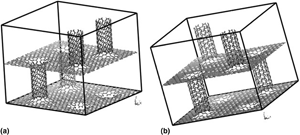Article contents
Investigation of thermal transport properties in pillared-graphene structure using nonequilibrium molecular dynamics simulations
Published online by Cambridge University Press: 06 August 2020
Abstract

This research focuses toward calculating the thermal conductivity of pillared-graphene structures (PGS). PGS consists of graphene and carbon nanotubes (CNTs). These two materials have great potential to manage heat generated by nano- and microelectronic devices because of their superior thermal conductivities. However, the high anisotropy limits their performance when it comes to three-dimensional heat transfer. Nonequilibrium molecular dynamics (NEMD) simulations were conducted to study thermal transport of PGS. The simulation results suggest that the thermal conductivity along the graphene plane can reach up to 284 W/m K depending on PGS’ parameters while along the CNT direction, the thermal conductivity can reach 20 W/m K.
Information
- Type
- Research Letters
- Information
- Copyright
- Copyright © Materials Research Society, 2020
References
- 3
- Cited by


